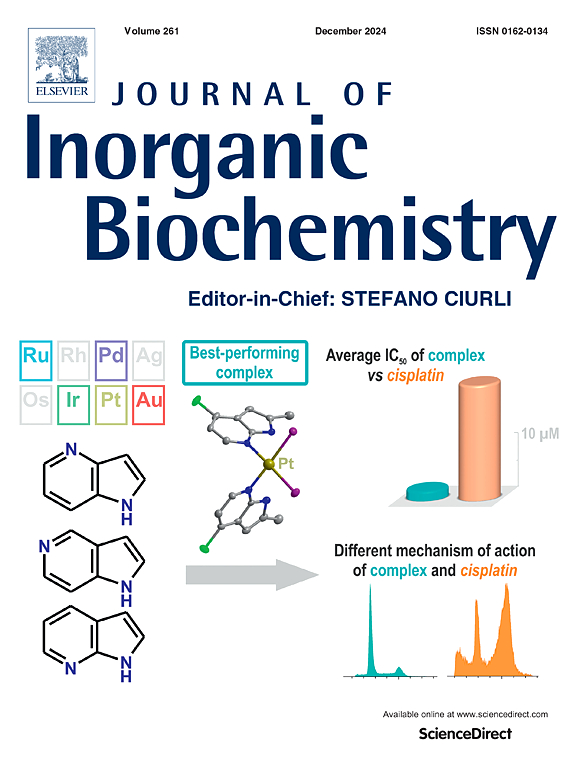Exploring Biginelli hybrids in the AI-driven development of ruthenium complexes: Anticancer activity, DNA/HSA binding study, impacts on apoptosis and BCL-2/BCL-XL suppression
IF 3.2
2区 化学
Q2 BIOCHEMISTRY & MOLECULAR BIOLOGY
引用次数: 0
Abstract
Ruthenium-arene complexes are promising alternatives to platinum-based anticancer drugs due to their unique chemical properties and lower toxicity. These complexes typically have a “half-sandwich” structure where an arene ligand stabilizes the ruthenium center. This study aimed to design tetrahydropyrimidines (THPM) and their ruthenium p-cymene complexes with anticancer potential using deep learning models for binding affinity prediction. Ten compounds with binding energies lower than −31.3 kJ/mol were selected for further investigation. Molecular docking studies revealed that the ruthenium complexes 5j and 5g exhibited the most pronounced activity against Caspase 3. These complexes showed significant cytotoxic activity and selectivity against primary and metastatic cancer cell lines, inducing apoptosis as the preferred mode of cell death through the modulation of Caspases expression. The Kb and Ksv values for the interaction of 5j with EB-DNA, Hoechst-DNA, HSA, HSA-Eosin Y, and HSA-Ibuprofen were higher compared to those of 5m. Binding constants in the presence of the tested BIO-ILs followed the order IL1 (ethanoate) < IL2 (butanoate) < IL3 (hexanoate), correlating with the length of the alkyl chain in the anions and the lipophilicity of the tested BIO-ILs. The best result of this study was that treatment with 5g induced apoptosis and reduced the expression of anti-apoptotic markers (BCL-2 and BCL-XL), which are associated with resistance acquisition. The research outcomes emphasize the integration of computational methods with experimental validation, underscoring the importance of collaboration between AI technologies and traditional chemistry in drug discovery.

探索Biginelli杂交种在ai驱动的钌配合物开发中的作用:抗癌活性、DNA/HSA结合研究、对细胞凋亡的影响和BCL-2/BCL-XL抑制
钌-芳烃配合物由于其独特的化学性质和较低的毒性,是铂基抗癌药物的有希望的替代品。这些配合物通常具有“半三明治”结构,其中芳烃配体稳定钌中心。本研究旨在利用深度学习模型进行结合亲和力预测,设计具有抗癌潜力的四氢嘧啶(THPM)及其钌对花素配合物。选择了10个结合能低于−31.3 kJ/mol的化合物进行进一步研究。分子对接研究表明,钌配合物5j和5g对Caspase 3的抑制作用最为明显。这些复合物对原发性和转移性癌细胞具有显著的细胞毒活性和选择性,通过调节Caspases的表达诱导细胞凋亡作为细胞死亡的首选模式。5j与EB-DNA、Hoechst-DNA、HSA、HSA- eosin Y和HSA- ibuprofen相互作用的Kb和Ksv值均高于5m。在所测试的bio - il存在时,结合常数的顺序为IL1(乙醇酸酯)<;il - 2(丁酸盐)<;IL3(己酸酯),与阴离子中烷基链的长度和所测试的bio - il的亲脂性相关。本研究的最佳结果是5g处理诱导细胞凋亡,并降低与耐药获得相关的抗凋亡标志物(BCL-2和BCL-XL)的表达。研究成果强调了计算方法与实验验证的结合,强调了人工智能技术与传统化学在药物发现中的合作的重要性。
本文章由计算机程序翻译,如有差异,请以英文原文为准。
求助全文
约1分钟内获得全文
求助全文
来源期刊

Journal of Inorganic Biochemistry
生物-生化与分子生物学
CiteScore
7.00
自引率
10.30%
发文量
336
审稿时长
41 days
期刊介绍:
The Journal of Inorganic Biochemistry is an established international forum for research in all aspects of Biological Inorganic Chemistry. Original papers of a high scientific level are published in the form of Articles (full length papers), Short Communications, Focused Reviews and Bioinorganic Methods. Topics include: the chemistry, structure and function of metalloenzymes; the interaction of inorganic ions and molecules with proteins and nucleic acids; the synthesis and properties of coordination complexes of biological interest including both structural and functional model systems; the function of metal- containing systems in the regulation of gene expression; the role of metals in medicine; the application of spectroscopic methods to determine the structure of metallobiomolecules; the preparation and characterization of metal-based biomaterials; and related systems. The emphasis of the Journal is on the structure and mechanism of action of metallobiomolecules.
 求助内容:
求助内容: 应助结果提醒方式:
应助结果提醒方式:


